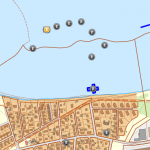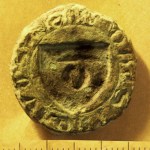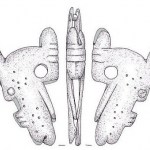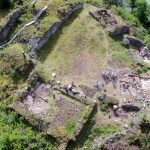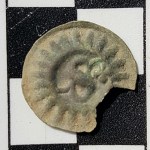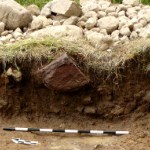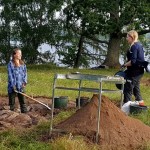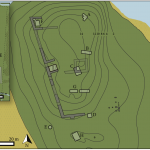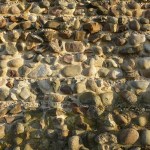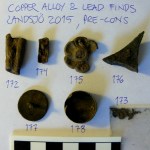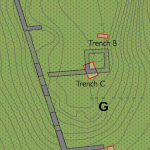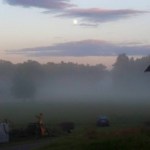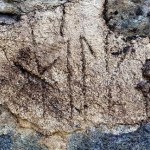medieval
Supported by a grant from the King Gustavus Adolphus VI Foundation For Swedish Culture, osteologist Lena Nilsson has analysed the bones we collected during excavations last year at two Medieval strongholds. Two weeks with 19 fieldworkers at Birgittas udde produced only 0.4 kg of bones, because the site has no culture layers to speak of and the sandy ground has been unkind. But from the following two weeks at Skällvik Castle we brought home 32.7 kg of bones! And now Lena has looked at them all. Here are her reports:
Birgittas udde 2016
Skällvik Castle 2016
The reports are…
Archaeological sites in Lake Vättern off Huskvarna
The latest inland ice was 3 km thick and its weight left a big dent in Scandinavia. Since deglaciation (which is, on the geological time scale, a current event) the dent has been straightening out. This causes land uplift. But just outside the edge of the dent, it causes the land to sink. Southernmost Scandinavia is losing land to the sea, not gaining it.
The fulcrum of this see-saw crosses Lake Vättern right at its southernmost point. The lake is receding at one end and encroaching at the other. This is why there is an Early Bronze…
My detectorist friend and long-time collaborator Svante Tibell found a seal matrix in the field next to Skällvik Castle this past summer. In the Middle Ages of Sweden, people of means didn't sign their names to documents. They carried seals around, with which they made imprints into chalk-mixed wax, and these were affixed to paperwork such as property deeds and wills. If you lost your seal matrix, you lost your ability to sign documents – and you theoretically gave that ability to whoever found your seal. When people died during this period, their seal matrices were carefully destroyed.…
Here's a guest entry by my correspondent Ben Bishop who's doing a project on Medieval scabbard mounts using data from the Portable Antiquites Scheme (PAS).
-----
I am researching medieval English scabbard chapes formed of folded copper alloy. They date from the period c. AD 1050–1300. The overwhelming majority are fragmentary when found and recognisable by the most decorative elements (shield for the mounted warrior, dragon head for the winged dragon). They are spread across England, including the Isle of Wight. The counties that are richest in these objects are Wiltshire (particularly L…
Our second week at Skällvik Castle proved a continued small-finds bonanza, and we also documented some pretty interesting stratigraphy.
More of everything in Building IV. In addition to more coins of Magnus Eriksson, dice and stoneware drinking vessels, we also found a lot of points for crossbow bolts. It's starting to look like the castle guards' day room! As for why we found crossbow bolts only inside one building and none outdoors in the bailey, I figure that they had been amassed there for re-fletching. The dark indoors find context and the undamaged sharp points show that the bolts did…
The famous royal castle of Stegeborg sits on its island like a cork in the bottleneck of the Slätbaken inlet (see map here). This waterway leads straight to Söderköping, a major Medieval town, and to the mouth of River Storån which would allow an invader to penetrate far into Östergötland Province's plains belt. The area's first big piece of public construction was 9th century fortifications intended to guard this entrypoint, in the shape of the Götavirke earthen rampart some ways inland and a wooden barrage at Stegeborg. This barrage was kept up for centuries, and indeed, the castle's name…
We spent Thursday afternoon backfilling. As I write this, only trench G remains open, and the guys there expect to finish soon. Here's some highlights of what we've learned during our second week at Birgittas udde.
Trench A in the outer moat demonstrated that the moat had a wide flat bottom, was not very deep and contains no lake sediments. Probably always a dry moat, providing material for the bank behind it. No Medieval finds.
Trench C: section through the deep inner moat.
Trench C in the inner moat demonstrated that this moat too had a wide flat bottom, but it was deeper and is full of…
Ulvåsa in Ekebyborna is a manor near Motala with two known major Medieval elite settlement sites. Excavations in 2002 proved that the unfortified Gamlegården site was established before AD 1100. The fortified Birgittas udde site has seen no archaeological fieldwork since 1924, when the main building's cellar was emptied and restored. Its date is only known to the extent that almost all moated sites of this kind in Sweden belong to the period 1250-1500. My current book project deals with Östergötland province's fortified sites of the High/Late Middle Ages, and so I decided to spend two weeks…
Myself, Ethan Aines and Mats G. Eriksson are proud to present our report on last year’s fieldwork at Stensö Castle, Östra Husby parish, Östergötland. Lots of goodies there, and with an added meaty report on the bones by Rudolf Gustavsson! It was a very fruitful two weeks at the site, during which we found the missing half of the perimeter wall, abundant fine pottery from around AD 1300, a runic inscription by a certain Helgi, the bones of a skinned cat, and more.
Here on Sb: Stenso 2015 Report (High-res, single-sided print)
And on archive.org.
See also the report for…
Myself, Ethan Aines and Mats G. Eriksson are proud to present our report on last year's fieldwork at Landsjö Castle, Kimstad parish, Östergötland. Lots of goodies there! Construction on the castle seems to have begun between 1250 and 1275, and the site was abandoned halfway through an extension project some 50-75 years later. We also found a Middle Neolithic fishing site and an Early Modern smallholding among the ruins.
Here on Sb: Landsjo 2015 Report (single-sided print-web, high res)
And on archive.org.
See also the report for 2014, the first documented excavations…
As with the bones from the 2014 fieldwork at Stensö Castle, Rudolf Gustavsson of SAU in Uppsala has again analysed the bones we found this year (report in Swedish here). And as expected, there are no human bones: this too is mostly food waste. The body parts represented indicate that trench D just inside the perimeter wall contained meal remains while trench F inside the south tower contained more butchery refuse.
The material is dominated by youngish pigs, a tell-tale marker of aristocratic housekeeping, followed by cattle and finally sheep/goat to a lesser proportion than in the 2014…
I spent last week in Denmark at a friendly, informative and rather unusual conference. The thirteenth Castella Maris Baltici conference (“castles of the Baltic Sea”) was a moveable feast. In five days we slept in three different towns on Zealand and Funen and spent a sum of only two days presenting our research indoors. The rest of the time we rode a bus around the area and looked at castle sites and at fortifications, secular buildings, churches and a monastery in four towns. Our Danish hosts had planned all of this so well that the schedule never broke down. Add to this that the food and…
Late Iron Age settlements are full of copper alloy objects, making them the preferred site category of metal detectorists. High Medieval castle sites, on the other hand, are quite poor in these often distinctive and informative finds.
The picture above shows all the copper alloy and lead that my team of ~15 found in over two weeks of excavations at Landsjö castle this past July, screening the dirt and using a metal detector in our trenches. Only seven objects! We collected 133 pieces of iron in that time, of which 77% are sadly nails in various states of completeness and thus not terribly…
2014 trenches A-E and rough locations of 2015 trenches F-H.
I write these lines on the day after we backfilled the last two trenches at Landsjö, packed up our stuff, cleaned the manor house, hugged each other and went our separate ways. It's an odd feeling to take apart the excavation machine while it still runs. It's been four fun and successful weeks!
Since my previous entry, written on Monday evening, we've done only three days of further excavation. Our main findings, to the extent that I have any comprehensive overview of them at the moment, relate to the culture layers sitting…
2014 trenches A-E and rough locations of 2015 trenches F-H.
Like Stensö, Landsjö Castle has half of a rare perimeter wall and is known to have been owned by a descendant of Folke Jarl – or rather, by his daughter-in-law, the widow of such a descendant. Last year we found that the high inner bailey has a previously unseen southern wall with a square tower at the east end, and we found five coins of AD 1250-75 in a deep layer that seem likely to date the castle's construction phase. But unlike Stensö, in three strategically placed trenches we found no trace of the missing bits of the…
Balancing available labour and a pre-decided excavation agenda against each other is not easy, particularly when you're doing investigative peek-hole fieldwork on a site whose depth and complexity of stratification you don't know much about. At Stensö we had two of three trenches and all five test pits backfilled in time for Wednesday lunch's on-site hot dog barbecue. Ethan Aines, Terese Liberg and three students stayed on to finish trench F, while myself, Mats Eriksson and six students moved to our new base at Landsjö Manor.
Trenches D and E and the test pits produced no big news after my…
This year's first week of fieldwork at Stensö Castle went exceptionally well, even though I drove a camper van belonging to a team member into a ditch. We're a team of thirteen, four of whom took part in last year's fieldwork at the site. All except me and co-director Ethan Aines are Umeå archaeology students. We're excavating the ruin of a castle that flourished in the 13th and 14th centuries. This year we have a very nice base at Smedstad, let to us by the genial B&B host Hans-Ola. But we cook our own meals, each day having its designated cooks and dishwashers, and in the evenings we…
Last year I headed four weeks of excavations at two previously unexplored castle ruin sites near the Swedish city of Norrköping: Landsjö in Kimstad and Stensö in Östra Husby. Finds and written sources suggest that both were built and inhabited in the 13th and 14th centuries. All known owners were members or close relatives of the powerful Ama family. Now Ethan Aines and I have finished the archive reports, available here on ScienceBlogs [Landsjö and Stensö] and on Archive.org. Rudolf Gustavsson's osteological reports (in Swedish) are included. Comments and questions are most welcome…
The Archangel Raphael. Recently uncovered mural in Kil church, Närke. C. 1250.
Today's my 16th anniversary as editor of Fornvännen! Issue 2014:3 is now on-line on Open Access.
Ole Thirup Kastholm on dugout canoes from before AD 1 on the Scandinavian peninsula.
Ole Stilborg on Late Bronze Age pottery from Östergötland.
Peter Tångeberg on recently uncovered Medieval murals in Kil church, Närke.
Påvel Nicklasson on early 19th century archaeological innovator Sven Nilsson’s female correspondents and on hints that Nilsson may have turned to folk magic when seasick.
Olof Holm on Iron Age metal…
Things are coming together with the post-excavation work for last summer's castle investigations so I'm putting some stuff on-line here.
I've submitted a paper detailing the main results to a proceedings volume for the Castella Maris Baltici symposium in Lodz back in May. There are no illustrations in the file, but you'll find all you need here on the blog in various entries tagged ”Castles”.
Osteologist Rudolf Gustavsson has completed his reports on the bones from the two sites (Landsjö – Stensö).
For the Dear Reader who doesn't read Swedish, a short summary of Rudolf's results is in order…
